By all accounts, Vancouver Canucks center Brandon Sutter had a solid performance on Saturday night in a 5-1 win over the Colorado Avalanche.
He registered an assist, had two shots on goal, led the team with four scoring chances and won seven of the 12 faceoffs he took. In a game where the Canucks were heavily out-possessed at five-on-five — recording just a 38.14 Corsi for percentage (CF%) — the 29-year-old was also one of just three players to have a positive impact on shot attempts (14 for, 13 against with him on the ice).
But here’s the kicker: that assist was Sutter’s first helper since opening night.
Wow…10 goalies have the same amount of assists as Brandon Sutter. #Canucks
— #ThankYouSedins #TeamPlayoffs (@xBraedenn) February 3, 2019
A grand total of two assists and six points is not pretty at this point in the season, even with Sutter being limited to 22 games because of an upper-body injury he suffered at the end of October. Since he returned to the Canucks lineup in January, he has registered one goal and one assist in nine games.
Now, I know Sutter’s job is not to put up points. He was brought in as a faceoff and defensive specialist to kill penalties and help mentor a young team. I get that. The problem is you don’t pay someone $4.375 million a season to do only that (it’s the third-highest cap hit of all forwards on the Canucks).
With Elias Pettersson unquestionably ready to handle himself as a center at the tender age of 20, and with Jay Beagle signed through 2021-22, there is simply no need on this team for Sutter anymore — not based on his current contributions (or lack thereof).
Sutter Has Been Terrible Defensively in 2018-19
I would be in favour of keeping Sutter if he had a positive impact defensively. Unfortunately, that hasn’t been the case.

Sutter has the second-worst goal differential at five-on-five of any Canucks player, at minus-12 (only Erik Gudbranson is worse, at minus-19). His 26.92 goals-for percentage (on the ice for seven goals for and 19 against) is the eighth-worst in the NHL for players with at least 200 minutes played.
For the last couple weeks, the most polarizing forward in Vancouver’s lineup was Nikolay Goldobin, a player who head coach Travis Green said needed to improve defensively. The young Russian was scratched for four straight games from Jan. 16 to 23 because Green didn’t think Goldobin’s play away from the puck was good enough. He sent him a message: work harder or you won’t play.
I’m not saying Sutter should be scratched instead of Goldobin, but I do find it interesting that Sutter’s shot suppression metrics are worse than Goldobin’s.
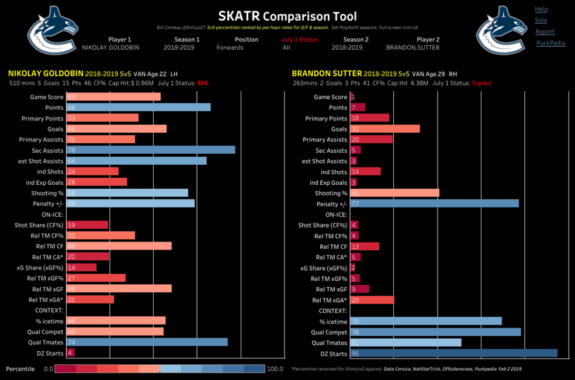
The first thing I noticed from the chart above was Sutter’s atrocious game score, which is in the first percentile. Game score not only measures offensive metrics like goals, primary assists and shots on goal, but it also considers blocked shots, penalty differential and faceoffs. This season, Sutter is one of only 22 players in the NHL to have a negative game score (according to Corsica Hockey, the Canucks have three of them).
There are two more important metrics I want to focus on: Corsi against relative to teammates (Rel TM CA) and expected goals against relative to teammates (Rel TM xGA). In both of these defensive-based statistics, Sutter has faired worse than Goldobin.
There are good reasons for this, however, which are eloquently displayed in the ‘context’ section. Sutter’s defensive zone starts are in the 95th percentile (Goldobin’s are in the fourth), Goldobin has had superior linemates and Sutter has faced tougher competition. If we compare Sutter to Beagle, however — someone who plays the same position and in similar situations — once again Sutter fares worse.
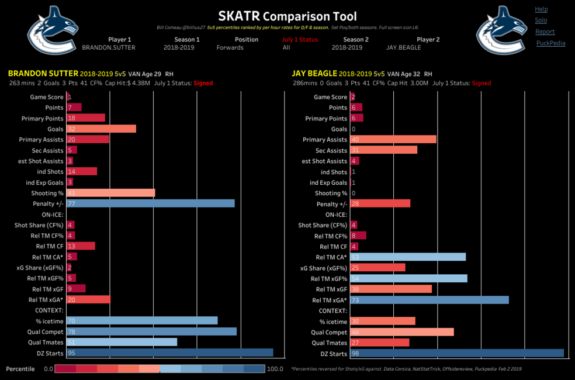
Beagle’s Corsi against per-60 relative to his teammates is in the 53rd percentile, while his expected goals against per-60 is in the 73rd percentile, which both blow Sutter’s numbers out of the water. In fact, Sutter’s 9.04 Rel TM CA/60 is the 15th-worst in the NHL, among players who have played at least 200 minutes at even-strength.
Another helpful tool is Micah Blake McCurdy’s unblocked shot rate charts, which help with the shot quality debate. The left chart below shows the location and frequency at which the Canucks allow shots when Sutter is on the ice (at even-strength). The right chart displays the same with Beagle. The difference is stark.
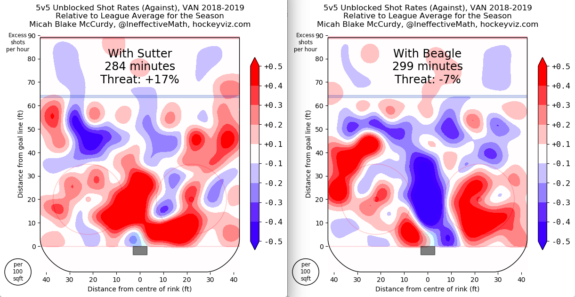
So, to recap: a) Sutter’s game score this season is in the last percentile in the entire NHL; b) his shots against per-60 and chances against per-60 this season are higher than both Goldobin and Beagle; and c) with him on the ice at even-strength, the Canucks allow a dangerous number of shots from in front of their own net, which is not the case for Beagle.
Sutter Wasn’t Always This Bad
From a defensive perspective, Sutter had a very strong 2017-18 season in Vancouver.
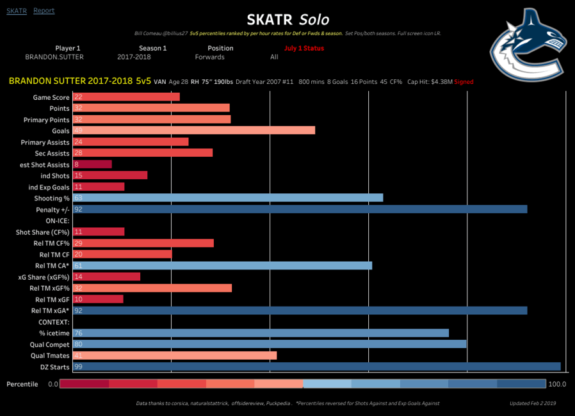
Once again, the important metrics are his minus-1.69 Rel TM CA/60 (61st percentile) and his minus-0.39 Rel TM xGA/60 (92nd percentile), both of which are very strong, considering his tough deployment.
Sutter was also second on the Canucks in faceoff wins last season with 570, despite only playing in 61 games, and he had a solid winning percentage of 51.7. From 2015-16 to 2017-18, Sutter’s 53.1 faceoff win percentage places him in the top-25 in the NHL. So far in 2018-19, Sutter’s faceoff win percentage has dropped to 49.26, his lowest since 2013-14.
So not only has Sutter’s even-strength defensive play dropped off, but his ability to win faceoffs has as well.
Still a Trade Market for Sutter
Despite a poor 22 games so far in 2018-19, many believe there are still teams interested in Sutter’s services. This is great news because I was nearly on board with buying him out this summer, which would save the Canucks $2.33 million in 2019-20 and 2020-21. Instead, the Canucks should be able to get assets back rather than just creating cap room. No matter how insignificant those assets are, something is better than nothing.
The tricky part about general manager Jim Benning moving Sutter before the deadline is he currently has a no-trade clause (NTC) in his contract, meaning he can’t be traded anywhere without his consent.
Hirsch: It's up to Brandon Sutter but we've seen guys with NTC's get moved. If I'm him and a Cup contender comes – I'm probably thinking about it. He loves Vancouver and wants to stay but you only get so many chances at a Stanley Cup.
— Sportsnet 650 (@Sportsnet650) February 1, 2019
As Sportsnet’s Corey Hirsch points out, the ball is currently in Sutter’s court, however, his power lessens this summer, because on July 1 his NTC turns into a Modified NTC. Sutter will have to submit a list of 15 teams that he cannot be traded to, instead of having full control.
I think it’s more likely a deal gets made in the summer, not only because of the modified NTC, but also because other teams will have more cap flexibility. In the offseason, teams can exceed the salary cap by up to 10 percent, which means taking on that $4.375 million per season contract is much easier.
But the Canucks should try their best to move Sutter now to keep stock-piling assets. Isn’t another third-round pick better than keeping him on your roster where he’s had a negative impact? Beagle would do just fine in the third-line center role, while Adam Gaudette should be able to handle fourth-line minutes.
Possible Destinations for Sutter
Teams that might want Sutter’s services at the deadline are likely all contenders, who, for the most part, are already right up against the $79.5 million cap. While that adds another layer of difficulty, let’s remember the Canucks can also retain some salary to make things work (they will almost certainly have to retain salary).
The first potential trade partner is the Washington Capitals, who don’t have a single center above 50 percent on faceoffs (they’re the worst faceoff team in the NHL). Evgeny Kuznetsov is a paltry 38.6 percent. I can see the Capitals thinking Sutter would be an improvement over Nic Dowd or Travis Boyd in the fourth-line center role. They’ve also been trying to shop winger Andre Burakovsky, who is making $3 million this season, and could have enough potential to entice the Canucks at just 23 years old.
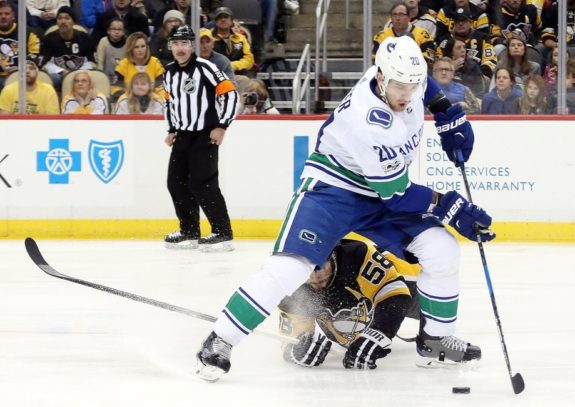
Another possible fit is the San Jose Sharks, who could use a fourth-line center upgrade over Barclay Goodrow or an insurance policy on the oft-injured Joe Thornton. They’re near the cap as well, and are probably looking for a bigger piece down the middle, but if that falls through, Sutter could certainly work.
The Pittsburgh Penguins could be a fit as well. They just moved Derrick Brassard to the Florida Panthers and currently have Jared McCann centering their third line. I imagine they are not done making moves and will acquire another center, so why not a reunion with Sutter?
Even though they’re last, the Montreal Canadiens may be the best fit, because they have the most cap space and their fourth-line center is 5-foot-9 Matthew Peca, who has never played in an NHL postseason and only has 50 regular season games on his resume. The Habs are exceeding expectations right now, currently one point back of the Toronto Maple Leafs and one point ahead of the Boston Bruins. They are also a bottom-10 team in the league in faceoffs and have been vocal in the past about wanting to “bulk up” at the center position. Sutter would do just that.
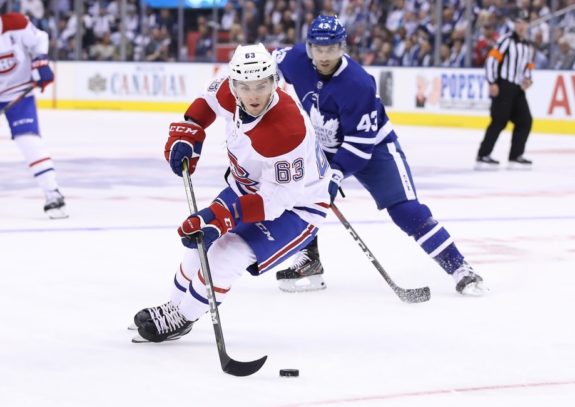
It’s clear the Canucks need to move on from Sutter and his bloated contract. He’s had a terrible season defensively and the Canucks depth down the middle is fine without him. Plus, there is a considerable market for a big, veteran center like him. Waiting until the offseason offers more flexibility for sure, but in the meantime, Benning should be working the phones to get something done in the next three weeks.